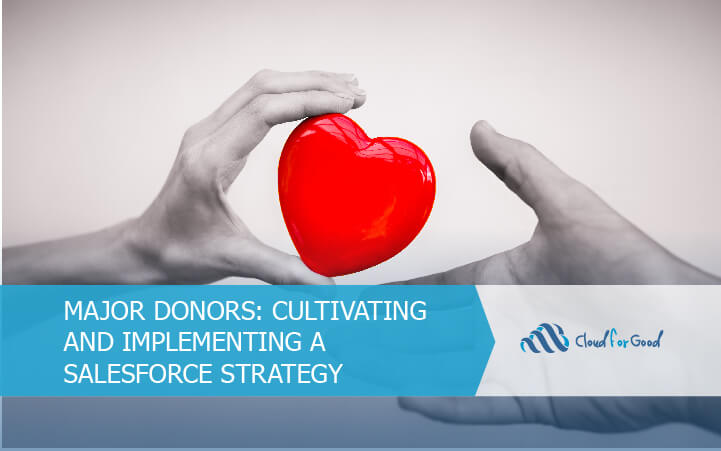In the realm of fundraising, major donors and the strategies around managing these portfolios can be one of the trickiest beasts to tame. While many other streams are process oriented, such as grant writing or meeting criteria set forth by a foundation, major donor giving involves consistent tailored engagement that allows you to share directly with a donor about your mission while learning about their motivations to give. I could write an entire book about major donor strategies (and many people have), but let’s explore how you can match highlights of a strong major donor vision to leverage Salesforce and the Nonprofit Success Pack.
Moves Management
The cornerstone of a strong major donor strategy involves being strategic with your moves management of these donors. A lot of smart thinking, solid strategy execution and countless hours go in to closing these gifts, and Salesforce is equipped to capture these critical moments.
While many organizations have a cadence of engaging with donors, it’s important to have a shared way of discussing donors and their “stages”. These can vary based on the org, but we typically see versions of a pipeline that begin with prospecting a donor (these stages sometimes live within Leads as donors become qualified), then to stages involving engaging with the donor, actually meeting with a donor, making the ask of a donor, and the subsequent result of that ask. Some examples being:
Find > Qualify > Engage > Convince > Ask > Verbal Commitment > Bookable > Cash-In or Lost
Or
Identification > Qualification > Solicitation > Cultivation > Negotiation > Pledged > Received or Lost
Note, these stages are currently from a lens of major giving. Salesforce also allows for the customization of Stages so that you can have differing ones for grants, foundations, in-kind giving, grass-roots giving – whatever differing record types you’d like!
These stages allow you to see the path a donor might take over the course of, typically, a fiscal year. They often won’t hit every stage, but it gives you a common way to discuss major donors and how individuals are currently intersecting with them. The stages also can allow for weighted pipeline predictions as within Salesforce these stages are link to a percentage and an Expected Amount that aids in conservative discussions around your path to goal and helps in even predicting your likely land throughout the year.
Additionally, we often talk about these as your pipeline. However, think of them less as a linear pipeline relationship where you get them through stages and the finish line is when the opportunity closes, but more of a cyclical relationship where they’re constantly engaged with your organization. As my own personal rule of thumb, at no point, ever, should there not be an open opportunity with one of your major donors. Once someone’s gift has closed, go ahead and create their next opportunity and begin building your future pipeline!
Engagement Plans
Once we have solid stages laid out for our org, we can then begin to build out engagement plans for our constituents. As described by Salesforce.org, “an Engagement Plan is a set of tasks (literally a “plan”) that helps you engage with your constituents”.
Given the complexity with major donors, they require that extra level of attention we mentioned above and Engagement Plans help you plan for, and track these activities. An Engagement Plan with a major donor could include, for example, scheduling a meeting between the donor and your Executive Director, then the actual meeting with the donor, then sending a follow-up note to the donor on engaging with your program, and so forth. You’d set up each of these activities as a task on the Engagement Plan, to be completed by a scheduled date.
With Engagement Plans, you can have one off plans set up that you can assign to similar donors and tailor to their needs on a case-by-case basis or you can set up an Engagement Plan when someone is noted as a particular Level based on aspects of their giving. Having these plans to work from help you streamline your execution on donor strategies and help keep track of the many tasks and touch points associated with closing major gifts.
Campaigns
Another place where Salesforce can help streamline strategy and execution is through leveraging Campaigns. A strong major donor strategy involves thought out campaign initiatives that meet your donors motivations. When fiscal year planning, take a step back and reflect on what campaigns you’d like to run in the upcoming year – perhaps a sponsorship of your program members, a STEM initiative, a small run or large gala – any development efforts that involve donors. Set these campaigns up in Salesforce, then map out your donor opportunities tied to these campaigns to help streamline activity with these donors.
For example, let’s say a donor has voiced interest in your “Sponsor a Program Member” campaign. They can then be targeted to receive further information about these campaign and your work within it, get to experience parts of the campaign like a “Meet Your Program Member” event and then ultimately give to that campaign and be matched directly with a Program Member, fostering a direct relationship with your organization. You can then leverage native Salesforce Campaign functionality to run reports on these campaigns to see how successfully they were and their return on your investment within them!
While major giving can be tricky, Salesforce is built to integrate with your strong strategy and help streamline management of these constituents, getting you where you need to be – in front of donors. There’s a ton of great best practices out there involving continuously improving your effectiveness with donors and with Salesforce’s flexibility you’ll be able to adapt the platform to bring in more dollars and getting you one step closer to achieving your mission!
You may also enjoy:





